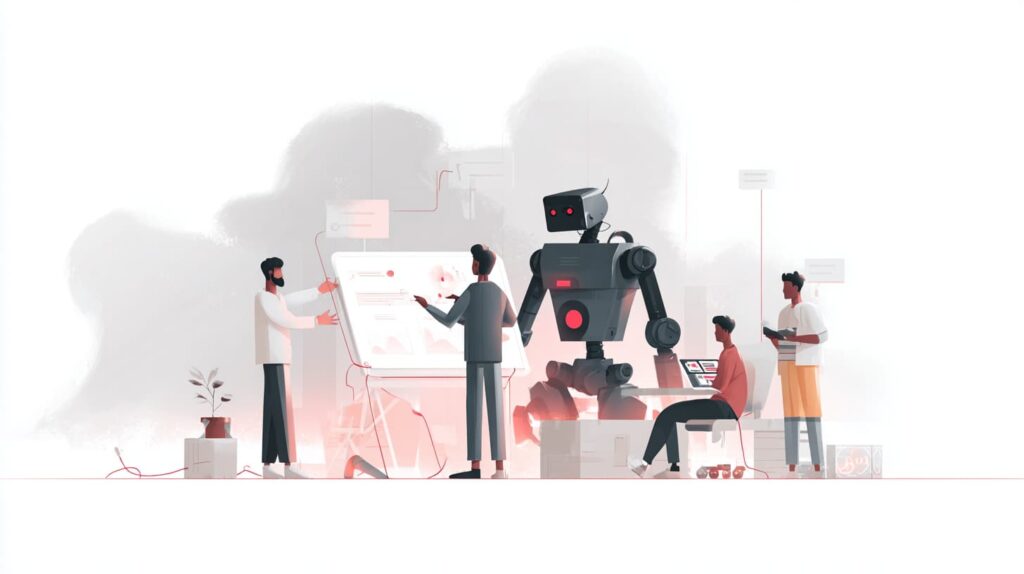By EloInsights
- Thiago Leite, partner at EloGroup, shares insights into Transformation trends saw in large companies from different sectors of the economy.
- Leite talks, for example, about the different approaches to the application of data lenses, Advanced Analytics and Artificial Intelligence, as well as the importance of using these levers in foundational projects capable of converting into high value for organizations.
- He also discusses the dependence often found in industry on partners to enable transformation when it comes to the application of digital lenses and how this dependence can be mitigated through upskilling programs.
What are the fundamental steps of a successful Transformation? How can we ensure that the transformation agenda within an organization is aligned with the company’s larger strategy and, thus, secure the sustainability of the transformational movement?
These are some of the topics addressed by Thiago Leite, partner at EloGroup, in this interview for EloInsights.
Leite reveals important insights gained from Digital Transformation projects carried out by EloGroup in large organizations in sectors such as services, pulp and paper, and steel. He talks, for example, about the different approaches surrounding the application of data lenses, Advanced Analytics and Artificial Intelligence, as well as the importance of using these levers in foundational projects capable of converting into high value for organizations.
He also discusses the dependence often found in the industry on partners to enable transformation when it comes to the application of digital lenses, and how this dependence can be mitigated through upskilling programs.
“It is not enough just to invest [in technology and data engineering],” says Leite in an excerpt from the conversation. “The acculturation of teams needs to accompany this process in order to build the foundations”.
Check out the interview with Thiago Leite below, full of important insights for any leader:
What do you see as the priority for companies today in terms of Transformation?
Digital acceleration has been a top priority for companies. We live in a context in which the customer experience is increasingly valued, and companies are looking for more efficiency. As a result, digital became a common agenda a few years ago. Those who have already gone digital want to make more gains, while those who have not yet, due to market lethargy or postponed investments, are chasing after it. This is true both for companies already consolidated in the market and for digital natives.
What are the main challenges you see in organizations on Transformation governance?
The first major challenge is to think about how to finance the transformation in broad terms, since it only gets off the ground if there are a few factors, such as a sense of urgency and the existence of a clear strategic agenda that directs the nature of these initiatives (efficiency, revenue generation, customer experience, etc.). This ensures that the projects developed will have a return for the business and that the transformation is worked on continuously.
The market demands that companies transform themselves all the time. So, this process cannot be limited to a single moment in time. The very nature of these transformations is different. Sometimes digital repositioning is needed. On other occasions, the aim is to replace products and services, for example.
When we talk about Digital Transformation, what levers and lenses have companies prioritized?
There is a great deal of concern today about increasing the scalability of an organization’s workforce. In other words, transforming existing capacity so that it can be more productive and cope, even if the organization undergoes some growth that will result in an increase in work demand.
This involves, for example, correctly structuring the process (“no process, no data, no automation”), automating processes and communication flows between areas, reducing friction and rework. This, in turn, will require the use of AI Agents to collect, organize, group and execute actions enhanced using GenAI. The development of self-service for external and internal customers is a second relevant lever.
Especially in the industrial, production and manufacturing sector, a third lever of Digital Transformation has been increasing the productivity of installed capacity, which involves getting the most out of existing plants and assets by expanding sensors and data collection and structuring intelligence centers for asset and process management to leverage the capacity of people and areas and act across the board to reduce maintenance costs and asset productivity.
How do you see the evolution of Digital Transformation specifically within industry in recent years?
The topic of Industry 4.0 has really advanced. The level of ignorance on the subject, for example, has greatly reduced. After a “disillusionment valley”, caused by initiatives with great appetite and little focus, today I see a greater balance between the investments made within companies and the actual return on these projects.
At EloGroup, we have worked with our clients on several extremely important projects in this area. And experience has shown that this market requires projects to be self-financed.
We often say that Digital Transformation is like a marine ecosystem. A strategy of “shark projects” (a few high-impact initiatives) has come to prevail, to the detriment of “shoals” (multiple projects that are not very transformational). The ideal is to form a balanced ecosystem of “coral” projects, which balance large, transformational projects with smaller, decentralized projects in the areas, which fund enabling projects capable of laying the foundation for data and technology (data lakes, for example).
I also notice that the industry’s leadership has become more acculturated on the subject, and this results in clearer demands, stronger partnerships and more enduring journeys.
At a steel mill we serve, for example, we were able to choose a very relevant problem for the organization and its variants, and focus all our energy on it, with a significant impact on the industry’s main productivity metric. By using the lens of data and Advanced Analytics, encapsulated in an integrated supply planning technology solution, we were able to solve the issue and generate a major impact.
In another example, at a pulp and paper company, we made a harmonization effort that identified around 325 projects related to Digital Transformation. Of these, we realized that five to ten would have a major impact. They were precisely the ones chosen for investment in the paper division’s various industrial units, using them as a basis for training the entire team and leadership involved in how to conduct and govern the transformation to generate results.
So, we realized that, instead of adopting a broader and more diffuse strategy of investing in hardware, sensors, etc., it might be more relevant to focus on a few good projects, with a great transformational impact, reducing pulverization and working better to train the base of people at management and operational levels involved in these projects.
How do you see companies maturing their approach to processing and using data?
Today, you can see two distinct movements in the market. In one, companies are investing heavily in data engineering to promote a better consumer environment. This creates a basis for the company to start doing data visualization and advanced analysis projects.
Due to a lack of training for the teams involved and/or governance to ensure prioritization, cloud costs often go through the roof. Therefore, without planning, the return will be very long, and it will be difficult to obtain funding for future foundational initiatives in the organization.
On the other hand, we also see the opposite happening. That is, a first concern to acculturate people, to raise important use cases, which unfold in the development of dashboards and more advanced analytical models, bringing with them the discussion of data structuring.
In this respect, despite the evolution of the Industry 4.0 theme, and looking at challenges even in countries with highly developed economies, we can see that it is not only the Brazilian market that finds a reality in which there is little or no structuring of the data used on the shop floor, which is often used in a limited way and processed manually, without its full potential being exploited. Generally, we note that there is still a great opportunity for evolution.
At EloGroup, we tend more towards acculturation and use cases that lead to data discussions. It is easier to justify financing this journey when you already have practical cases with tangible returns.
The discussion of data structuring is part of this “package”, financed by the opportunities mapped. It is precisely the use cases that will dictate which sources should then be prioritized through the lens of data engineering, composing a data ingestion “roadmap” that responds to the organization’s needs in time and avoids an excessive increase in cloud costs before there is a clear capture of returns from the projects.
In this same context, how do you see the debate on the application of Artificial Intelligence in companies evolving?
When we talk about focusing on a smaller number of initiatives with high added value, these will inevitably need the use of artificial intelligence, since the potential for transformation is generally directly associated with the application of advanced models capable of dealing with large volumes of data. In other words, this movement towards market and company maturity, anchored in analytical projects in the industry, has AI as a strong accelerator.
What is often perceived is that companies still rely heavily on third parties to accelerate this movement – especially industries. In some specific businesses, this dependence is on the third parties themselves who provide the machinery or act as plant integrators. We therefore see a significant need for companies to internalize this competence, which is why EloGroup has developed an upskilling offer to meet this need.
Naturally, other levers are needed to further accelerate this capacity. Hence the growth in the use of low-code tools to develop automations. We have seen a strong trend towards the application of low-code tools to support the use of artificial intelligence in industry. Platforms are already emerging that accelerate this and allow even in the context of a team with a lower level of data literacy, it is already possible to start obtaining value.
What is the main recommendation you would give today to a leader who wants to move Digital Transformation forward in their company?
There are four main pillars, and their prioritization will depend on each company’s moment.
First, there must be a transformation agenda. This agenda is a direct result of the company’s strategy. So, if the transformation agenda is digital, the agenda needs to clearly unfold the company’s strategy; this needs to be very clear and reflected in challenges and milestones to be met and connected to the organization’s value tree. Is it plant productivity? Back-office efficiency? Adoption of new channels?
The existence of an agenda is fundamental if you want to start discussing a transformation and ensure its viability through strong strategic alignment. So, if the board has not yet made this agenda or has not unfolded it, this is an important first step.
The second pillar is to build good governance to unfold this agenda into projects, ensuring that they have a clear scope and goals and traction. This can be done internally, with the team itself, or with a hybrid team, both internal and external. The important thing is that the skills needed to carry out these projects are identified and made available within the company.
The feasibility of these projects is the third pillar of this process. If the organization has an internal team, naturally these people need to be acculturated to work correctly on the levers that will make that project viable.
Similarly, another lever must be the acquisition of skills on the market, either through partnerships with third parties or possibly through acquisitions or hiring talent. It is not uncommon for companies to get or invest in startups, for example, to make this agenda practical and internalize skills that were not available in the organization until then.
It is even recommended that the acquisition of competent personnel be discussed in parallel with the construction of the agendas. This guarantees that the skills will be available when they are needed.
Governance ensures the cadence and accelerated pace of this transformation, removing barriers and adjusting priorities over time. This is important because strategy can also change and is constantly being renewed.
Finally, the fourth pillar involves building foundations so that the transformation continues even after the execution of a first transformational agenda. Transformation cannot be a “house of cards”. Therefore, these foundations, made up of people, technology and data, need to be workable. Again, ideally, building the foundation should also be part of the agenda the company is discussing.
In short, these are the four fundamental pillars: directing, governing, accelerating and building foundations.











